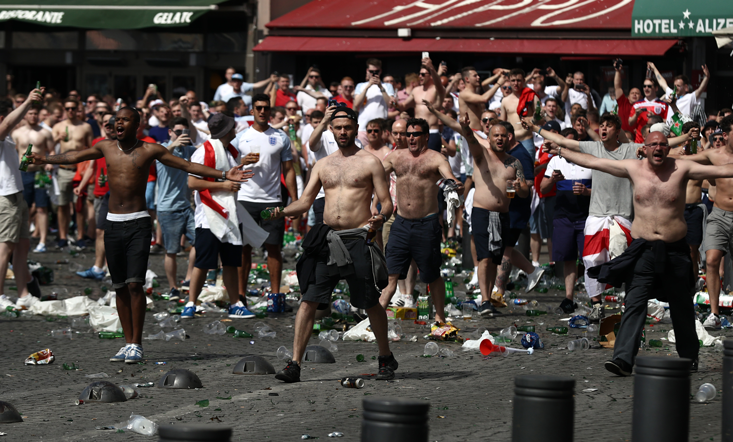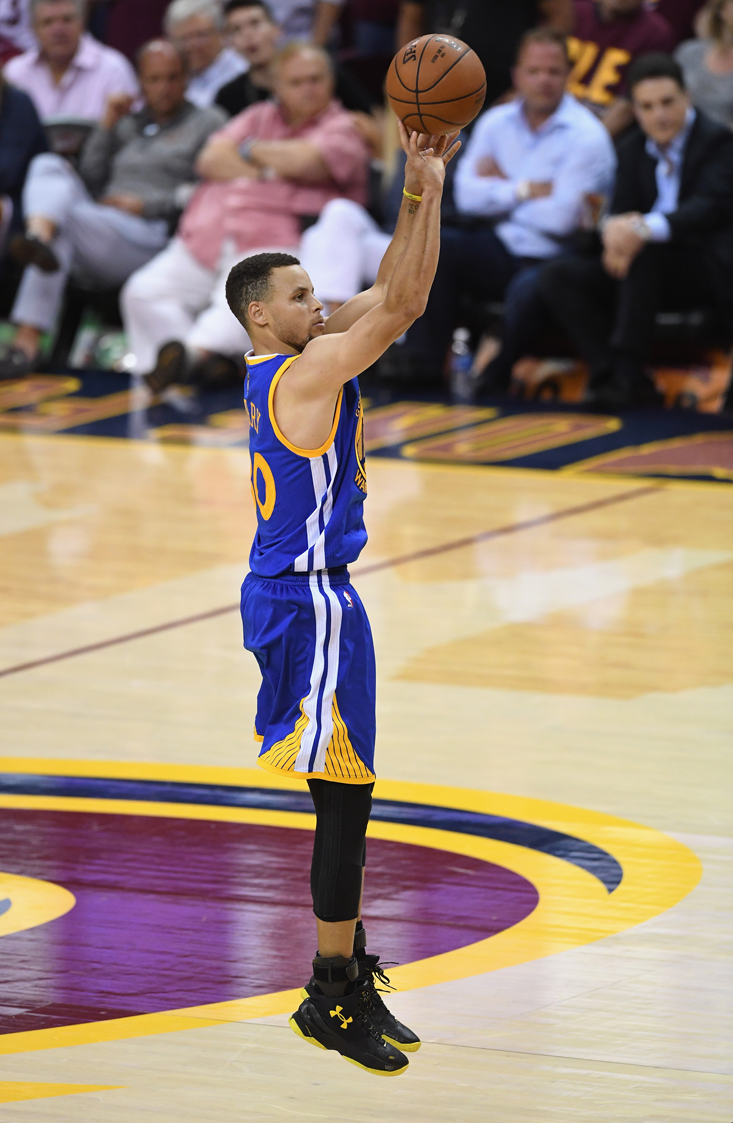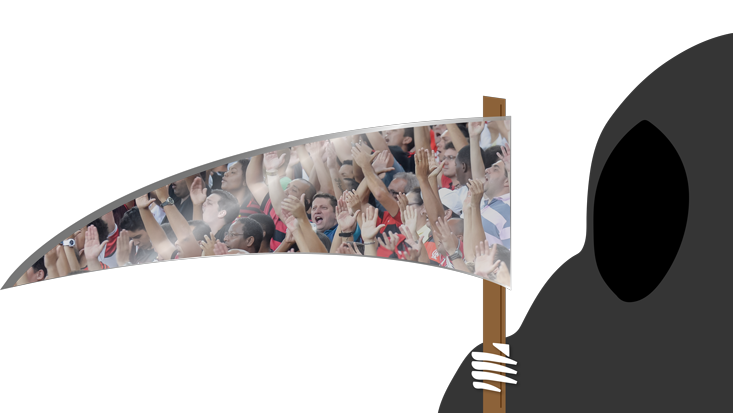The soccer match hadn’t even started when the cops showed up. On the streets of Marseille, France, the officers—helmeted, shields in hands, batons on belts—charged through a crowd to break up a thicket of English and Russian fans who were hurling bottles, threats, and insults at each other. Some fans were bare-chested, caked with dried blood, screaming at the top of their lungs. Others clutched plastic cups of beer while trying to avoid the clouds of tear gas. The scene broke up when a knot of fans left for the hospital to have injuries treated, or in handcuffs with a cop at their side.
The brawl happened in June at the beginning of the Euro 2016 soccer tournament. But the annals of extreme fan behavior are Biblical in scope. Fans in Constantinople in A.D. 532 spent a week violently rioting after a chariot race in what historians today call the “Nika riots.” It’s estimated that thousands died. In the Sydney Riot of 1879, an umpire decision at a cricket match led to 2,000 spectators storming the pitch and “a scene of confusion ensued, and blows were received and returned,” according to a local newspaper.

Unruly fan behavior at Veterans Stadium in Philadelphia, home of the Eagles, got so bad over the decades that in 1997 it had its own in-stadium courtroom to deal with fans urinating in sinks, smuggling alcohol, and fighting in the stands. In 2011, Pennsylvania State University students clashed with cops as they protested the termination of football coach Joe Paterno in the wake of a pedophilia scandal. Two years later, 17 people were killed in post-boxing match riots in Indonesia.
Zeal for sports also upends our personal finances, as we dump half a trillion dollars in the industry, erect stadiums in communities in the name of athleticism, and worship athletes as members of our community to a religious degree. The 2016 Olympics are under way in Rio de Janeiro despite the Zika virus, waters polluted with “super bacteria,” a cratering Brazilian economy, and uncertainty about who, exactly, is the country’s president.
What is it about sports that drives us to the psychological fringe? For eons, sports have been a cesspool of metaphors: sports are war, sports are religion, sports are business, sports are love, sports are hate. Sports are life. But according to a branch of social psychology called terror-management theory, the answer is not found in the bleachers, it’s found in the graveyard. Sports are not about life. They’re about death.
An outgrowth of Ernest Becker’s 1974 Pulitzer-Prize winning tome, The Denial of Death, terror-management theory posits that human beings experience a psychological conflict between wanting to live and realizing death’s inevitability. In Becker’s view, the world is terrifying and human behavior is motivated by a biological need to cope with anxiety. “This is the terror,” Becker writes. “To have emerged from nothing, to have a name, consciousness of self, deep inner feelings, an excruciating inner yearning for life and self-expression—and with all this yet to die.”
In an uncertain world, death is the only thing that is a given. The “main task of human life is to become heroic and transcend death,” Becker writes. So we adopt a hero system that permits us to believe that death is transcended when we participate in something immortal, something that will last beyond us: an empire, a religion, a sports team.
“We’re all trying to create meaning out of our existence,” Jeff Greenberg, a professor of social psychology at the University of Arizona, says. “If you’re a Yankee fan, you bask in the tradition of those World Series wins. It’s a sense of heroism that we all want.”
Sports are fertile territory for terror-management theory, Greenberg says. He and colleagues Sheldon Solomon and Tom Pyszczynski are credited with developing the theory in the 1980s, and have found some of the universality of sports has provided the perfect laboratory for testing their theories (as well as a personal passion). “Sports are a symbolic version of the drama of life,” Greenberg says. “That’s one of the reasons we get caught up in it so easily. Winning and losing feels like life and death.”
What drives fans to the psychological fringe? The answer is not found in the bleachers, it’s found in the graveyard.
In several studies, Greenberg, Solomon, and Pyszczynski have applied their ideas to sports. The inspiration came from their own experience, as they were friends who found themselves often in impassioned debates over which of their football or basketball teams was superior to the other’s. They were, perhaps ironically, psychologists at a loss for how to explain their behavior.
“The underlying significance of sports fanship is that need to feel good about yourself, the need for self-esteem and significance,” Greenberg says. “Terror management theory is about why we need that. What’s the point? Why do we need to feel valuable and good about ourselves and our significance in the world?”
Our conflicts—including those like the battle between British and Russian soccer fans in France—can be perceived as struggles of life or death, one person’s immortality project against another’s, a war to gain self-esteem and a heroic self-image, desires for the best that can result in the worst. A riot is an expression of anger, violence, and it brings us closer to death as the illusion of the team as a hero has shattered. It isn’t merely about a team losing, it’s about feeling lost ourselves.
“In a sense, that’s what we’re doing in our lives,” Greenberg says. “Trying to feel transcendent of our mortality, to feel higher than death, that somehow we’re going to continue on beyond.”
In aligning ourselves with athletes, Greenberg says, we live vicariously through them. Each cheer from the stands, chest bump, high-five, or dollar spent on a jersey is a tiny chip at trying to make an imprint on the world in the face of the inevitable Grim Reaper. However fleeting the sensation may be, that elevated feeling is a perfect cocktail of the potency of human psychology and the linear narrative of sports. There’s a winner and a loser in a bounded domain. Given these high emotional stakes, it’s less surprising that when things run sour, fans resort to violence.
“If we see affiliation to sports as a psychological microcosm of a tribe or nation then a riot or violence is just an extrapolation of a defensive reaction,” Solomon says.

The terror-management theorists have applied what they’ve observed in stadium bleachers to other realms, including politics and Hollywood. In examining George W. Bush’s comments after the terrorist attacks of 9/11, the researchers argued that people who were reminded of their own mortality were more likely to support Bush and his policies. In another study, they found that those who were reminded of death were more likely to desire fame, including an increased interest in having a star in the galaxy named after oneself, part of “the desire for symbolic continuance beyond death.”
Athletes, Solomon says, can’t stop with mere fame. “As an athlete, it’s like fame on steroids. You’re famous, but not just famous for being famous. You also have to be able to do something that renders you unique in the world, you have to be able to beat everyone on earth. You’re doing a physical feat that appears to be transcending the boundaries of time and space. You’re doubling down on fame and the supernatural.”
Passionate fandom can also lead to a kind of social blindness. Look at the reactions to Penn State pedophile scandal.
Death can also motivate athletes. In a study of 35 college males who played basketball titled “He Dies, He Scores,” Greenberg and colleagues found that those who thought about their mortality performed better in a “one-on-one” basketball simulation than participants in a control condition who did not think of mortality. The group of players who completed a questionnaire about mortality before playing saw an increase of more than 20 percent of the average points scored than a control group that did not complete the questionnaire, including that they were more likely to take and make 3-point shots.
The 3-point shots, the authors wrote, were probably a faster strategy for winning the game, and with the increased motivation to win after being primed for death-related thought, participants were more willing to take the risk. The researchers speculated that the focus on scoring points, rather than other aspects of the game like turnovers or rebounds, was because 3-point shots most directly affected the goal of the game: earning points.
Through this lens, one could argue that nonpareil 3-point shooter Steph Curry of the Golden State Warriors is a veritable Kierkegaard, fear and trembling before death, securing his place in the world long after he’s gone. Neuroscience studies show that athletes and fans share the same rush of neurochemicals and hormones in performing and watching sports. So it’s little wonder that every 3-pointer that Curry hits from downtown feels like a jolt of immortality, a point against death.
It’s unclear at what moment fandom turns from having fun to being full of rage. Some of that may depend on the values and ethos of the sport itself. Solomon points to the contrast between a soccer team entering the field holding the hands of kids as the roster is announced, compared with hockey players skating onto the ice, ready for a fight. “You can ritualize good sportsmanship,” he says. “Those displays are good for displaying certain values within a sport.” But if those displays are absent, or hollow, it doesn’t take much for the passion of fans to turn into a negative direction. “Plus,” Solomon notes, “there’s alcohol.”
What can easily be dismissed as a bunch of people drunkenly screaming, though, is quite neurologically complex, explains Samuel Sommers, a professor of psychology at Tufts University who has studied fandom. “People have physiological reactions to watching sports,” Sommers says. “Their blood pressure goes up, they sweat. When you look at fMRI studies, you can see increased blood flow for regions of the brain associated with pleasure when they look at the team they’re rooting for. When you see the success of rivals, you see more brain activity related to perceptions of pain. We have a visceral reaction to sports, and at a neural level, you can see that people take their sports seriously.”
Losing your inhibitions is a potent brew for Robert L. Rogers, III, by day a corporate litigator in Orlando, but on the weekends, an impassioned Florida Gators fan. He attended his first Florida Gators football game as a freshman at the school in 1994. “There’s some arrogance as a fan, a religious responsibility,” Rogers says. “You yell at every down. There are fans who say they need to save their voices. I’m a litigator, I use my voice in court every day, but there’s an obligation to yell as a fan. I’m not afraid of going to work hoarse. At work, I’m Clark Kent, but on the weekends, I have this football alter ego. I’m polite, but rabid. I yell like I’m Braveheart.”

Most of fandom, of course, sans riots, is in good fun. There may be a certain, normal human level of aggression inherent in a person, and sports can provide a safer arena for that expression than, say, a battlefield.
Mina Cikara, director of the Harvard Intergroup Neuroscience Lab, who has studied fandom, explains in the Nautilus article, “The Unique Neurology of the Sports Fan’s Brain,” also in this issue, that the dynamics of fandom—ingroup vs. outgroup, or my team vs. your team—may stem from the same instincts, rooted in evolutionary biology and tribalism, that fuel racial intolerance and wars. However, she says, sports are a constructive outlet for those instincts. “Sports is a place where we as a society have decided that it’s OK to say nasty things and root for the downfall of another,” she says.
Except when it’s not. Passionate fandom can also lead to a kind of social blindness. “We need to be cautious,” says Solomon. “Look at the reactions to Penn State. Paterno was idolized to the point where everyone turned a blind eye. This is a danger of any heroic belief system. It’s a testament to the fact that there’s something much more powerful going on here than just an affection for sport. When Paterno was ousted, people rose up and revolted because when push comes to shove, there was so much symbolic meaning and self-worth tied up in being a Penn State fan.”
A scandal involving a team we love creates a cognitive dissonance that can be difficult to reconcile, a sense of disbelief and moral conflict that people and symbols we held up as good may no longer hold. The catharsis that was supposed to come from Paterno’s leadership and construction of a winning and academically robust football program, suddenly became that of a man who ignored a serial pedophile in the name of winning.
“It was like a Jimmy Stewart film,” Solomon says, of Penn State’s reputation before the sex-abuse scandal. “It showed the fallibility of an icon who represented the entire psychological ball of wax being demolished. It was much easier for people to just argue the indictments against him were wrong.” Solomon pauses. “It’s not exactly a flattering depiction of humankind.”
Scandals, riots, and violence, say the terror-management theorists, are a reminder that sports, despite being couched in the entertainment business, and promoted as escapism, are more than a game. The elation they provide, and the heartbreak and anger they unleash, come with a stinging realization of mortality. In the parlance of the sports bar: YOLO. You only live once.
Mary Pilon is the author of The New York Times bestseller The Monopolists and the forthcoming The Kevin Show. She previously covered business at The Wall Street Journal and sports at The New York Times and is a producer for NBC Sports at the 2016 Summer Games in Rio. You can find her at marypilon.com and on Twitter @marypilon.
Lead collage credit: CP DC Press / Shutterstock






























